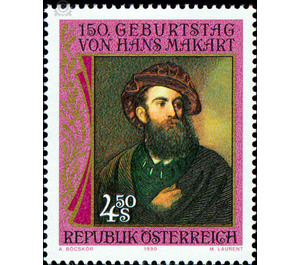150th birthday - Austria / II. Republic of Austria 1990 - 4.50 Shilling
Theme: Art & Culture
| Country | Austria / II. Republic of Austria |
| Issue Date | 1990 |
| Face Value | 4.50 |
| Color | multi-colored pink |
| Printing Type | combination printing |
| Stamp Type | Commemorative |
| Item Type | Stamp |
| Chronological Issue Number | 1334 |
| Chronological Chapter | OOS-OE2 |
| SID | 612776 |
| In 66 Wishlists | |
On May 28, 1840, Hans Makart was born in Salzburg. After a brief visit to the Vienna Academy of Art, he moved to Munich and entered the studio of history painter Karl von Piloty in 1861. He studied there until 1865. Already in 1868, his painting cycles "Modern Amorets" and "The Plague in Florence", exhibited in Munich, became a social scandal with their portrayal of naked women, which suddenly made him known throughout Europe. In March of the following year he was officially called to Vienna as a kind of "state artist". The "painter prince" coined in the episode of the Austrian variety of historicism, which was named after him "Makart-time". With his perfectly staged lifestyle, he became the cultural leader of an epoch and gave his time the aesthetic ideal in fashion, home decor and lifestyle. He died on October 3, 1884.


